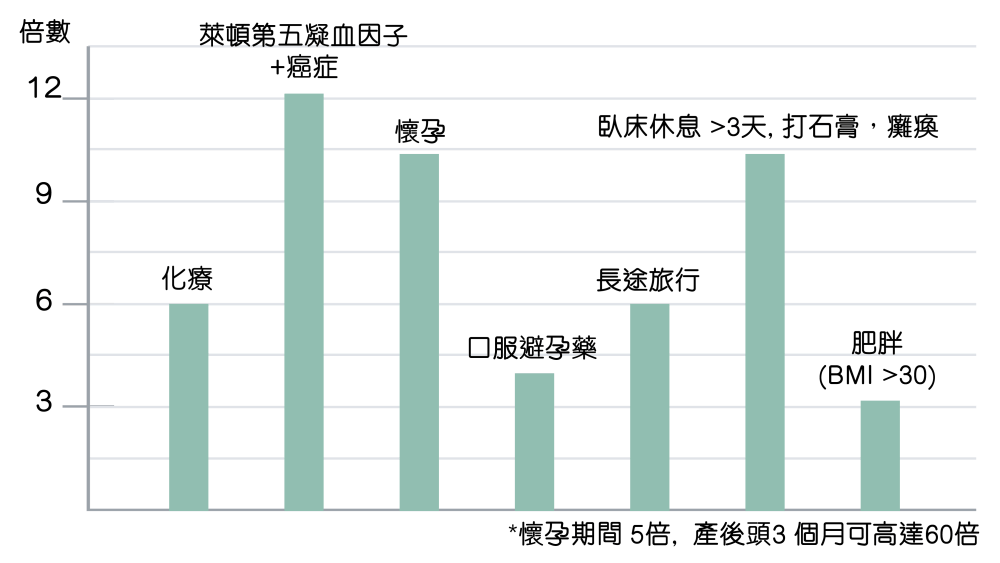易被忽略的血栓

血栓是血管中形成的血塊,當血塊愈來愈大,就會塞住血管,造成血栓塞症。
血栓形成易產生血栓體質的成因很多,其中基因變異是先天(遺傳)性易產生血栓體質的風險因素,有相關基因突變的人發生血栓風險將會增加80倍。
| 全球每年有10, 000,000人因血栓形成而患上靜脈栓塞 | |
| 根據世界衛生組織 (WHO) 的統計資料顯示,血栓是造成心腦血管疾病的一大因素之一。因心腦血管疾病導致的死亡人數,比癌症的致死率還要來得高,可稱為人類健康的第一殺手。 |
先天性血栓形成風險會導致什麼危險?
| 增加心腦血管病發送風險,如中風,冠心病,猝死。 | |
| 增加不良妊娠結果風險,如死胎、流產,胎兒生長受限、子癇前症、胎盤早剝 | |
| 增加慣性流產風險。 |
誰應該進行此測試?
| 擔心發生血栓的人士 | |
| 吸煙 | |
| 肥胖 | |
| 40歲以上 | |
| 遺傳因素或患上心血管疾病的家族歷史 |
測試詳情
| 測試代碼 | 測試方法 | 樣本要求 | 測試所需時間 |
|---|---|---|---|
| GTR | 桑格 (Sanger) 基因測序 | 6ml EDTA 血液 | 5個工作天 |
詳情請電郵至info@pangenialife.com或致電+852 3989 6160聯絡我們。
參考資料
- 1. White RH. The epidemiology of venous thromboembolism. Circulation. 2003;107(23 suppl 1):I4-I8.
- 2. https://www.cdc.gov/ncbddd/dvt/data.html US CDC, Data and Statistics on Venous Thromboembolism.
- 3. Liew NC, Alemany GV, Angchaisuksiri P, Bang SM, Choi G, De Silva DA, et al. Asian venous thromboembolism guidelines: updated recommendations for the prevention of venous thromboembolism. Int Angiol 2017;36:1-20. DOI: 10.23736/S0392-9590.16.03765-2
- 4. Lee LH, Gallus A, Jindal R, Wang C, Wu CC. Incidence of Venous Thromboembolism in Asian Populations: A Systematic Review. Thromb Haemost. 2017 Dec;117(12):2243-2260. doi: 10.1160/TH17-02-0134. Epub 2017 Dec 6. PMID: 29212112
- 5. De Stefano V, Leone G (1995). "Resistance to activated protein C due to mutated factor V as a novel cause of inherited thrombophilia". Haematologica. 80(4): 344–56. PMID 7590506.
- 6. Poort, Swibertus R, Rosendaal, Frits R, Reitsma, Pieter H, & Bertina, Rogier M. (1996). A common genetic variation in the 3'-untranslated region of the prothrombin gene is associated with elevated plasma prothrombin levels and an increase in venous thrombosis. Blood, 88(10), 3698-3703.
- 7. Frosst, Phyllis, Blom, Henk J, Milos, R, Goyette, Philippe, Sheppard, Christal A, Matthews, Rowena G, . . . Van Den Heuvel, LP. (1995). A candidate genetic risk factor for vascular disease: a common mutation in methylenetetrahydrofolate reductase
- 8. Den Heijer, M, Lewington, S, & Clarke, R. (2005). Homocysteine, MTHFR and risk of venous thrombosis: a meta‐analysis of published epidemiological studies. Journal of Thrombosis and Haemostasis, 3(2), 292-299.
- 9. Andreassi, M. G., Botto, N., & Maffei, S. (2006). Factor V Leiden, prothrombin G20210A substitution and hormone therapy: indications for molecular screening. Clinical Chemical Laboratory Medicine, 44(5), 514-521.
- 10. Wulf, G. M., Van Deerlin, V. M. D., Leonard, D. G. B., & Bauer, K. A. (1999). Thrombosis in a patient with combined homozygosity for the factor V Leiden mutation and a mutation in the 3'-untranslated region of the prothrombin gene. Blood coagulation & fibrinolysis, 10(2), 107-110.
- 11. van der Put, N. M., Gabreëls, F., Stevens, E. M., Smeitink, J. A., Trijbels, F. J., Eskes, T. K., ... & Blom, H. J. (1998). A second common mutation in the methylenetetrahydrofolate reductase gene: an additional risk factor for neural-tube defects?. The American Journal of Human Genetics, 62(5), 1044-1051
- 12. Previtali, E., Bucciarelli, P., Passamonti, S. M., & Martinelli, I. (2011). Risk factors for venous and arterial thrombosis. Blood Transfus, 9(2), 120-138.
- 13. Rabe, T., Luxembourg, B., Ludwig, M., Dinger, J. C., Bauersachs, R., Rott, H., ... & Albring, C. (2011). Contraception and Thrombophilia-A statement from the German Society of Gynecological Endocrinology and Reproductive Medicine (DGGEF e. V.) and the Professional Association of the German Gynaecologists (BVF e. V.). Journal für Reproduktionsmedizin und Endokrinologie-Journal of Reproductive Medicine and Endocrinology, 8(1), 178-218.




